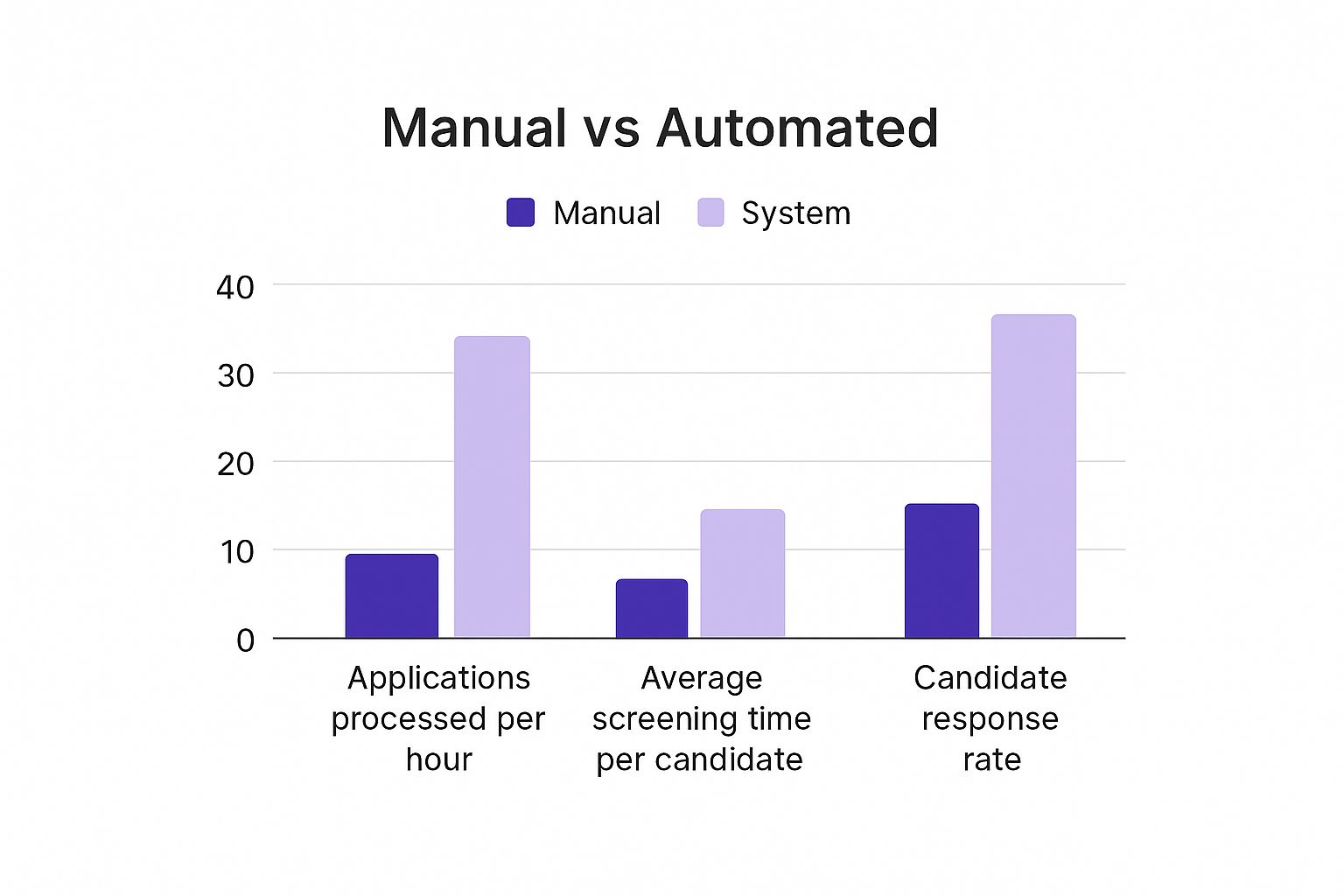What Is a Job Application Management System?
Picture this: you're trying to direct rush-hour traffic in a major city, but you have no stoplights, no signs, and no traffic cops. It's pure chaos. That’s pretty much what modern recruiting feels like without the right tools—a frantic mess of overflowing inboxes, disconnected spreadsheets, and candidate details that seem to vanish into thin air. A job application management system is your traffic control center, designed to bring sanity and order back to your hiring process.
Taming the Chaos of Modern Recruiting

In the race to land top talent, speed and organization aren't just nice-to-haves; they're everything. When you've got a handful of amazing candidates in the pipeline, a slow or disorganized process is a surefire way to lose them to a competitor who moves faster. Let's be honest, the old way of juggling resumes in email folders and tracking interviews on spreadsheets just doesn't cut it anymore.
This manual approach is more than just inefficient—it's a real business risk. It leads to a terrible candidate experience, frustrates the heck out of your hiring managers, and makes it impossible to gather any real data to improve your strategy. Key information gets lost in the shuffle, follow-ups are missed, and the entire team is left flying blind.
The High Stakes of Inefficient Hiring
The fallout from a messy hiring process goes way beyond simple frustration. Every great candidate you lose is a missed opportunity and a waste of everyone's time and effort. Just think about the common headaches that pop up when you're trying to track everything by hand:
- Scattered Information: Candidate details are all over the place—some in emails, others in local folders, and more in various spreadsheets. There's no single source of truth.
- Poor Candidate Experience: Without a system, timely communication falls through the cracks. Candidates are left hanging, which seriously damages your company's reputation.
- Lack of Collaboration: Recruiters and hiring managers struggle to share feedback, causing delays, bottlenecks, and inconsistent evaluations.
- No Actionable Insights: Manual methods make it nearly impossible to track key metrics like time-to-hire or which job boards are actually working. You can't improve what you can't measure.
Think of this guide as your map for getting out of that mess. We’ll break down how a job application management system acts as a central command center, turning hiring chaos into a smooth, repeatable, and successful operation.
A good system doesn't just organize applications; it builds the foundation for scalable growth. It ensures you can find and hire the best people, time and time again, no matter how fast your company is expanding.
While we're focused on the recruiter's side of things, it’s worth noting that job seekers can benefit from similar tools. To see how tech can help on the other side of the hiring desk, check out our post on using a job search organizer to effectively manage a job hunt.
So, What Exactly Is a Job Application Management System?
Think of a job application management system as the central command center for your entire hiring process. It's so much more than a digital filing cabinet for resumes. It’s an intelligent hub built to organize every application, automate communication, and track each candidate's unique journey from start to finish.
Let's use an analogy. A general Customer Relationship Management (CRM) tool is like a family doctor—it can handle a wide range of common issues pretty well. A job application management system, on the other hand, is a specialist, like a surgeon. It's purpose-built with the precise tools and workflows you need for recruiting. Everything about it is designed for one main goal: making your hiring faster, smarter, and more effective.
This specialized focus is what makes it so powerful. It's not just about storing files; it's about solving the real, everyday headaches recruiters face and creating a smooth, repeatable process for your team.
More Than a Digital Filing Cabinet
The real purpose of one of these systems is to bring order to the chaos of hiring. It helps you shift from putting out fires and drowning in admin tasks to making proactive, strategic moves that actually help the business grow. This happens by zeroing in on four key areas:
- Taming the Workflow: It automates all those repetitive tasks like sending "we got your application" emails, scheduling interviews, and chasing down feedback from the hiring team.
- Improving the Candidate Experience: It ensures every single applicant gets timely and consistent communication, which is huge for protecting your company's reputation.
- Making Data-Driven Decisions: It gives recruiters real, actionable data to make smarter choices about where to find talent and how to improve their process.
- Keeping Things Fair: It creates a structured path so every candidate is evaluated using the same benchmarks, which helps ensure fairness and consistency.
If you want to get into the nitty-gritty of the technology that drives these platforms, this guide on understanding Applicant Tracking Systems is a great place to start. They are often the engine running under the hood.
This chart really drives home how much more efficient a dedicated system is compared to doing everything by hand.

The numbers don't lie. A proper system can help a team process four times as many applications and slash screening time by over 80%. That translates directly into a better, more engaging experience for candidates.
Core Features That Drive Hiring Success

A good job application management system is more than just a bucket of software tools. It’s an entire ecosystem where every feature pulls its weight to solve a real-world hiring headache. When you understand these core functions, you start to see how these platforms shift recruiting from a constant fire drill into a smart, forward-thinking strategy.
Think of it like a professional workshop. You wouldn't try to build a house with only a hammer. You need saws, drills, and measuring tapes, each designed for a specific job. In the same way, a solid system gives you a full suite of specialized tools for every single stage of hiring.
Centralized Candidate Database
The absolute foundation of any system is a centralized candidate database. Imagine every resume, cover letter, note, and email chain for every applicant, all neatly organized in one secure, searchable place. This isn't just a digital filing cabinet; it’s your company's living talent pool.
Instead of frantically searching through old emails and messy spreadsheets for that great candidate you spoke to six months ago, you can just run a quick search for "Python developer" or "project management." Suddenly, you have a private repository of talent to tap into for new roles, which saves a massive amount of time and sourcing money.
Automated Resume Parsing
Let’s be honest: manually typing in data from hundreds of resumes is a soul-crushing, error-prone task that eats up precious hours. Automated resume parsing is the antidote. When a candidate applies, the system intelligently scans their resume and automatically fills out their profile with all the key details—work history, skills, education, you name it.
This does way more than just save time. It standardizes every candidate profile, making it a breeze to compare applicants on an even playing field. This one feature helps make your screening process fairer and more objective by ensuring everyone is evaluated on the same criteria.
A job application management system acts as your team's collective memory. It ensures that valuable candidate interactions and insights are never lost, even as team members change, creating a foundation of institutional knowledge.
This is exactly why the market for these tools is exploding. In 2024, the Applicant Tracking System software market hit a global value of USD 2.5 billion, and it’s on track to reach USD 3.6 billion by 2029. The best platforms automate everything from managing resumes to tracking workflows, proving just how essential they’ve become.
Customizable Hiring Pipelines
No two companies hire the same way, and your software shouldn't force you into a box. A great job application management system lets you build customizable hiring pipelines that actually match how your team works. You can create your own unique stages—like "Application Received," "Phone Screen," "Technical Interview," and "Offer Extended"—and move people through them with a simple drag-and-drop.
This visual layout gives you a bird's-eye view of your entire hiring operation. Managers can see exactly where every candidate is at a glance, spot bottlenecks before they become major problems, and work together more smoothly. You can even visualize this progress with an interactive job tracker that lays it all out on a timeline or kanban board.
Integrated Communication Tools
Keeping candidates in the loop is everything. Nothing kills your employer brand faster than radio silence. Integrated communication tools let your team email candidates, send automated updates, and schedule interviews without ever leaving the platform.
Here’s how it usually works:
- Automated Acknowledgements: The moment someone applies, the system automatically fires off a confirmation email. Simple, but it makes a huge difference.
- Bulk Updates: Need to let a group of candidates know they didn't make it to the next round? You can send a single, polite update to all of them at once.
- Templated Messages: Your team can create and save email templates for common messages, keeping the tone consistent and saving tons of time.
This kind of automation ensures no one ever feels like their application vanished into a black hole. The table below really drives home the difference between the old way and the new way.
Manual Hiring vs. System Automation
A quick look at how these systems turn painful manual tasks into simple, automated workflows.
| Hiring Task | The Manual Way (Without a System) | The Automated Way (With a System) |
|---|---|---|
| Resume Review | Opening individual files, manually scanning for keywords, and creating separate notes. | Resumes are automatically parsed, keyword-searchable, and attached to a central profile. |
| Candidate Updates | Manually composing and sending individual emails for every stage, often leading to missed follow-ups. | Automated, templated emails are triggered as candidates move through the hiring pipeline. |
| Team Collaboration | Forwarding long email chains and trying to consolidate feedback from different documents. | All notes, feedback, and ratings are stored on the candidate's profile for easy team access. |
| Scheduling Interviews | Endless back-and-forth emails trying to find a time that works for everyone. | Integrated calendar tools allow candidates to self-schedule based on the team's availability. |
As you can see, it’s not just about saving a few minutes here and there. It's about completely overhauling the process to make it more efficient, collaborative, and human-friendly for everyone involved.
How a Centralized System Really Changes the Game

Sure, the features are great. But the real magic of a job application management system is how it completely flips a company’s entire hiring process. This isn't just about doing the same old things a bit faster; it’s about turning a chaotic, reactive mess into a smart, well-oiled machine.
Think about "Company A," a startup that's growing fast. Their hiring process was a total nightmare—a jumble of spreadsheets, messy email inboxes, and sticky notes everywhere. Great candidates were falling through the cracks, and their tiny HR team spent 70% of their week buried in admin work instead of actually finding people.
The result? Hiring was painfully slow, managers were frustrated, and they were getting a bad rap with local talent. Sound familiar? It’s a common story, but it doesn’t have to be yours. A centralized system lets you rewrite that script.
Finally, You Can Stop Wasting Time
The first thing you'll notice is just how much time you get back. A job application management system is like having the world’s best administrative assistant, one who handles all the boring, repetitive stuff so your team can focus on what they do best—connecting with people.
Just think about all the hours spent manually sending confirmation emails, scheduling interviews, or hounding managers for feedback. Automation just makes those tasks disappear. This efficiency adds up fast, letting a small team handle way more applicants without pulling their hair out.
It's no wonder the Applicant Tracking System market shot past USD 7.43 billion in 2025 and is expected to nearly double by 2035. With roughly 27% of companies now using HR automation for hiring, teams are making a serious dent in that average USD 4,500 cost per hire in the U.S.
A centralized system gives your team back its most valuable resource: time. They can finally stop being reactive paper-pushers and start being proactive talent advisors who actually move the needle.
Crafting a Killer Candidate Experience
In a tough job market, your candidate experience is your brand. A slow, confusing, or totally silent hiring process sends a clear message: you’re disorganized. A job application management system makes sure every single applicant gets timely, consistent, and professional communication.
From an instant confirmation email to automated updates when they move to the next stage, the system keeps people in the loop. That simple act of respect can be the one thing that makes a top candidate choose your offer over a competitor's. It shows you value their time right from the start.
Get Everyone on the Same Page
Hiring is a team sport, but too often it feels like nobody is playing by the same rules. Without a central hub, communication falls apart. Feedback gets buried in email chains, and hiring managers have zero idea what’s going on in the pipeline.
A centralized system fixes all of that by creating a single source of truth.
- Shared Notes and Ratings: Everyone can see comments, interview feedback, and scores right on a candidate’s profile.
- Real-Time Pipeline View: Managers can see where every candidate is in the process at a glance—no more shoulder-tapping for updates.
- Clear Accountability: You can assign tasks to team members so everyone knows exactly what they need to do and when.
This kind of transparency is a game-changer. The upsides are a lot like the broader Benefits of Knowledge Management Systems—when everyone can easily access and act on shared information, you get way better results.
This collaborative setup leads directly to smarter, data-driven hiring. Instead of just going with a gut feeling, your team can look at real numbers like time-to-hire, which sources bring in the best candidates, and interview-to-offer ratios. This data shows you what’s working and what isn’t, so you can fine-tune your strategy and bring in better talent, every single time.
How to Choose the Right System for Your Team
Picking the right job application management system feels like a massive decision—because it is. This tool is about to become the central nervous system for your entire hiring operation, so you really want to get it right. The market is packed with options, and they all claim to be the magic bullet, which makes it tough to figure out where to start.
The trick is to ignore the flashy features you’ll probably never touch. Instead, get brutally honest about how your team actually works. The best system isn't the one with the most bells and whistles; it’s the one that just fits—the one that solves your real-world headaches.
Start by Mapping Your Current Process
Before you even think about watching a demo, grab a whiteboard and map out your hiring process. I mean every single step, from the moment a job is posted to the final offer letter. But more importantly, find the cracks. Where do candidates fall through? Where do communication wires get crossed? What mind-numbing manual tasks are sucking up all your team's time?
What you're doing here is creating a "pain point inventory." This list becomes your guide. It stops you from just making a generic wishlist and forces you to define what you actually need the software to fix. For instance, if your biggest bottleneck is scheduling interviews, then a system with a slick, built-in calendar tool should be at the top of your list.
Doing this first ensures you’re shopping for a solution, not just another piece of software. It gives you a solid framework to judge every platform against your team's real needs.
Create a "Must-Have" vs "Nice-to-Have" Checklist
Once you know your pain points, turn them into a feature checklist. The key is to split it into two columns: must-haves and nice-to-haves. This simple exercise keeps you grounded so you don't get wowed by a cool feature that doesn’t actually solve one of your core problems.
Here are a few things to think about for your list:
- Ease of Use: How intuitive is the dashboard? If it’s clunky and confusing, no one will use it, and you’ve just wasted your investment. Your team should be able to get the hang of it without weeks of training.
- Integration Capabilities: Does it talk to the tools you already rely on every day, like your email, calendar, or main HR system? Having to manually copy-paste information between systems is a huge time-waster.
- Scalability and Growth: You need a system that can grow with you. Think about whether it can handle more applicants, more users, and more complexity as your company gets bigger. Different plans are often available for various organizations to handle this.
- Customer Support: When you hit a snag—and you will—how good is their support? Dig into reviews and ask about their support model. Is it a real person on the phone, or are you stuck talking to a chatbot?
Your goal is to find a system that adapts to your team, not the other way around. Get your whole hiring team involved in making this checklist. It ensures everyone’s needs are met and gets them excited about the new tool from the get-go.
Test Drive Before You Commit
You wouldn't buy a car without taking it for a spin, right? The same logic applies here. Almost every vendor offers a free trial or a guided demo, and you should take them up on it. This is your chance to get past the sales pitch and see how the software actually feels to use.
During the trial, don't just click around aimlessly. Run a real job opening through the system with your team. Have them post the role, screen a few test candidates, leave comments, and drag them through your hiring stages. This hands-on experience is the single best way to know if a platform is a true fit. It’ll expose any hidden frustrations or workflow killers, so you can make your final choice with complete confidence.
So, What Makes Eztrackr Different?
Look, we know there are a lot of systems out there. The right job application management system shouldn't feel like another piece of software you have to learn. It should feel like a partner, helping you hire smarter. We built Eztrackr to be that partner.
Instead of throwing a million features at you that you'll never touch, we focused on what actually makes a difference for growing teams and busy recruiters. This isn't just about managing applications; it's about changing how you find great people. We believe a great system should be powerful but simple, proactive instead of reactive, and accessible to everyone.
It's Just… Easy to Use
Let's be honest, the most advanced software on the planet is useless if your team hates using it. We built Eztrackr to be clean and intuitive from the ground up.
Your team can get going in minutes, not weeks. That means less time spent on training and more time finding great candidates.
"Eztrackr is incredibly easy to navigate. I didn't need any training to figure it out, which was a huge relief for our busy team. We were organizing candidates within the first hour."
When a system is this easy, people actually use it. That's how you get an accurate, up-to-date hiring pipeline you can trust.
Keeping Candidates in the Loop
In a tight job market, a good candidate experience is your secret weapon. Eztrackr helps you build one with features designed to keep people engaged. Think automated follow-ups and templated messages—no more "application black holes" that can damage your company's reputation.
This is what it looks like in action. Eztrackr gives you a clean, drag-and-drop kanban board to see your whole pipeline at once.
Every column is a different stage, so you get a bird's-eye view of every candidate's journey. You can spot bottlenecks before they turn into real problems.
By automating the routine stuff, your team is freed up to focus on what matters: preparing for interviews and building real relationships with top talent. That personal touch is what makes your company stand out and win the best people.
Pricing That Makes Sense for Your Business
Too many powerful hiring tools come with a massive enterprise price tag, leaving smaller businesses out in the cold. We wanted to fix that.
Eztrackr gives you robust, scalable features that grow with you. You get the power you need today without paying for a bunch of stuff you don't.
Right from the start, you get the tools you need to succeed:
- Centralized Database: A single place for every candidate and every interaction.
- Visual Pipelines: Drag-and-drop your way through your custom hiring stages.
- Automated Communication: Keep candidates happy without lifting a finger.
- Actionable Analytics: Use real data to make smarter hiring decisions.
This blend of simplicity, engagement, and affordability makes Eztrackr the perfect choice for teams ready to build a better hiring process. If you're looking to take things to the next level, check out what’s included on our Eztrackr Pro page. It’s the best way to scale up your recruiting without blowing up your budget.
A Few Common Questions We Hear
Jumping into the world of hiring software can feel a bit overwhelming, and it's natural for a few questions to pop up. As you think about how a job application management system could work for your team, let's tackle some of the things people often ask.
First off, many people wonder if this is just another name for an Applicant Tracking System (ATS). While the terms get tossed around interchangeably, there's a real difference. An ATS is typically focused on the nitty-gritty of tracking and compliance. A modern job application management system, on the other hand, takes a wider view, focusing on the entire candidate journey from that first click to the final handshake.
Do Small Businesses Really Need One?
You bet they do. In fact, you could argue they need one even more than the big guys. When you're on a small team and everyone is wearing multiple hats, your time is your most valuable asset. A good system takes all that administrative busywork off your plate—the stuff that can totally bury a small HR team or a lone hiring manager.
It also helps you punch above your weight. A streamlined system lets you offer a smooth, professional experience that makes your small company look just as polished as your larger competitors. That’s a huge advantage when you’re trying to attract top talent.
How Do These Systems Help With Hiring Compliance?
Let's be honest, hiring comes with a whole lot of legal red tape, and staying compliant is non-negotiable. A job application management system gives you a solid framework to manage those risks.
By standardizing your hiring process, these systems ensure every single candidate is looked at through the same lens. This is a huge step toward fair hiring and helps keep unconscious bias out of the picture.
Here’s a quick breakdown of how they keep you on the right track:
- Consistent Processes: The system walks every applicant through the same steps and ensures they get the same communications, creating a uniform experience.
- Secure Data Storage: It gives you one safe, central place to keep sensitive candidate info, helping you stay on top of data privacy rules.
- Reporting Help: Many systems can pull the reports you need for things like EEO (Equal Employment Opportunity) and OFCCP (Office of Federal Contract Compliance Programs), making a very complex task much simpler.
Ready to stop juggling spreadsheets and start making smart hires? Eztrackr gives you the simple tools you need to manage your pipeline, connect with great candidates, and make decisions backed by data. Get started with Eztrackr today and see how easy recruiting can be.
 Interview Sidekick
Interview Sidekick